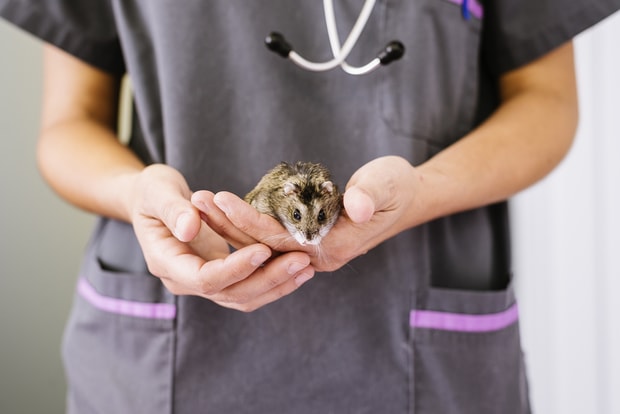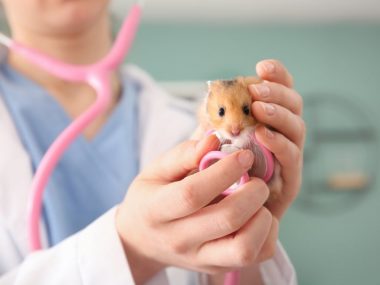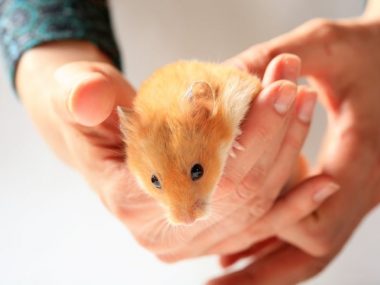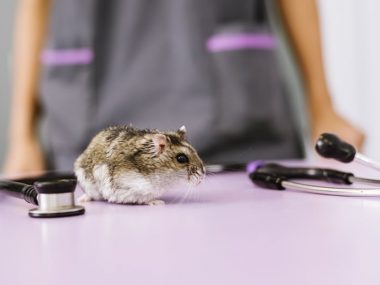If your hamster’s eyes aren’t looking as shiny and adorable as usual, it is worth taking a second look. Pink eye isn’t only for humans, and our tiny rodent friends can also be affected by this itchy, mucky condition that can steal the twinkle from their bright eyes.
Pink eye is a condition medically known as conjunctivitis. It is characterized by inflammation or redness around the edges of the eyes. In more severe cases, it can include a sticky discharge. Pink eye should be treated by a veterinarian who will determine the cause and treat accordingly.
Although pink eye in humans and hamsters have similar symptoms, the causes may differ considerably. While the condition is seldom life-threatening, it is uncomfortable, so let’s find out more about hamster pink eye and what you can do about it.
Table of Contents
What Is Hamster Pink Eye?
Even the best cared for hamster can occasionally develop conjunctivitis. The condition affects the tissue around the animal’s eyes and causes them to become inflamed and irritated. This irritation leads to the distinctive pink, or even red, color around the lining of the eyes.
Unlike pink eye in humans, which is either viral or bacterial, hamsters can develop pink eye from various unexpected sources. These include:
Irritation or allergy to the bedding – If you have only recently got your hamster or are using a new type of bedding, your little pet may be allergic to it. Remember that your hamster’s face is pretty close to the ground, and they love to burrow below the surface, so choose bedding that is safe, hygienic, and suitable for your little pet.
Dental problems – Sometimes, a hamster’s swollen pink eyes may result from overgrown, painful teeth, also called malocclusion. This is particularly common in older hammies as the teeth wear down unevenly. Treatment may include a trip to the veterinarian to file down the offending teeth.
An injury or bite wound – Redness and swelling around the eyes may also have a physical cause. If your hamster has had a run-in with its cage buddy or scratched its cornea on something in the cage, it might result in watery, swollen eyes.
Bacterial infection – Like humans, hamsters can get bacterial pink eye. This can be successfully treated with antibiotic eye drops from your veterinarian.
How To Know If My Hamster Has Pink Eye?
Several conditions can affect your hamster’s eyes, and everything from an ulcer to an allergy could cause your little pal to rub its eyes. Pink eye, which is also sometimes called sticky eye, often includes the following tell-tale symptoms:
- Watery or mucky discharge from the eyes
- Dry discharge can stick the eyelids together and have a crusty appearance
- The eyes may appear swollen
- The rim of the eyes is pink or red
What Must I Do If My Hamster Has Pink Eye?
If you notice that your hamster’s eyes have a gluey discharge or a dry crust around the edges, you can clean them using a warm, damp cloth. Remove any dry gunk gently. Don’t try to get it off all in one wipe because it may need to soften up first.
Saline eye drops can be used to wipe the outside of the hamster’s eyes. Gently wipe the outside with a cotton ball soaked in a sterile saline solution. Don’t ever force its eyes open if they are swollen or stuck closed.
If you suspect your hamster is allergic to a new type of bedding, immediately change to a different brand. Allergies often also include symptoms like itching or wheezing.
You might not be able to tell if the underlying cause of pink eye is the hamster’s overgrown teeth or bacterial infection. The best option is to take your hamster to a veterinarian who can assess the situation and provide the correct treatment. The faster treatment begins, the quicker your buddy will be back to its healthy, bright-eyed self.

How To Prevent My Hamster From Getting Pink Eye
There is a common adage that an ounce of prevention is worth a pound of cure. This is certainly true for preventing pink eye for your hamster. While even healthy pets may develop pink eye occasionally, there are some things you can do to significantly reduce the chance of your pet being affected by this uncomfortable condition.
Keep The Cage Clean
Regularly disinfecting and sanitizing the hamster cage and changing the bedding can reduce the spread of harmful bacterial organisms. The more concentrated the nasty bugs become in an environment, the less chance your hammie’s immune system can fight them off.
Sometimes, even though the cage appears clean, you might find that your hamster has a favorite hidden spot inside a cardboard tube or tunnel with a buildup of dirt. Regularly checking and cleaning every part of your hamster’s cage will limit the spread of bacteria.

Separate Your Hamsters Until Infection Has Cleared
If your hamster has bacterial pink eye, move any cage buddies to a different clean cage as it can quickly spread from one animal to another. Sterilize everything if you move food bowls or water drinkers into another cage.
Check The Bedding
Bedding containing small particles must be avoided, and some types of wood bedding, like pine or cedar shavings, may even contribute to respiratory problems. Select bedding that is safe and allows your hamster to burrow and stay warm without any risk of eye irritation.
Provide Plenty of Chew Toys
While dental issues are sometimes unavoidable (even for humans!), providing your hamster with plenty of toys that it can chew will give it the opportunity to wear its teeth down naturally. This may indirectly keep pink eye at bay, as conjunctivitis is often caused by hammie’s teeth growing too long.
Frequently Asked Questions
Can I Use Pink Eye Drops On My Hamster?
Mucky eyes can be gently wiped using a warm, wet cloth. If there is a crusty, dry layer, a cotton ball soaked in saline eye drops can be used to clean the area.
It is not advisable to use human pink eye products on your hamster unless directed by your vet. The animal may need specific antibiotic eye drops or even an oral antibiotic, so using the incorrect treatment may further inflame the eyes or even cause damage.
What Is Wrong With My Hamster’s Eye?
Many conditions may affect your hamster’s eyes, so it is always advisable to consult a veterinarian as soon as you notice a problem.
While conjunctivitis is the most common eye condition affecting hamsters, the pet may have an injury or ulcer. Other notable hamster eye conditions are proptosis which may occur if the hammie has somehow been squeezed a little too hard, and exophthalmia which results in bulging eyes.
It is better not to take chances with your precious pet and get any eye irritation seen to quickly. While pink eye itself is not fatal, it can lead to other health problems.
How Do You Give A Hamster Antibiotics?
Never give your hamster any antibiotics unless directed by a veterinarian. Hamsters are extremely fragile little animals and can quickly die if they receive incorrect medication.
If your hamster has pink eye, a vet may prescribe a carefully measured oral antibiotic that you will need to give using the dropper provided. First, draw the required dose into the dropper or syringe and have it ready.
Next, hold the hamster gently by the scruff of the neck using your dominant hand. Be careful not to squeeze the animal, and don’t lift it off the ground as you may drop it if it wriggles. Push the tip of the dropper into the hamster’s cheek and squeeze the medicine out. It may squirm a little, so be prepared. No one likes taking medicine, so be sure to reward your hamster with a tasty treat after the ordeal.
References:
https://www.petmd.com/exotic/conditions/eyes/c_ex_hm_conjunctivitis
https://www.thesprucepets.com/eye-problems-in-hamsters-5095745
https://pubmed.ncbi.nlm.nih.gov/2926083/
https://www.merckvetmanual.com/all-other-pets/hamsters/routine-health-care-of-hamsters






